The Microsoft Surface Laptop 3 Showdown: AMD's Ryzen Picasso vs. Intel's Ice Lake
by Brett Howse & Andrei Frumusanu on December 13, 2019 8:30 AM ESTGPU Performance - Vega vs Iris
After many tests, it is very clear that Intel’s Ice Lake platform offers a significantly faster CPU, and the results were unsurprising. Although the Ryzen Mobile 3000 platform did launch in 2019, it already struggled on CPU tests against the older Skylake core processors. But on the GPU side, Intel is the one that needs to play catch-up. Previous to Ice Lake, Intel’s standard GT2 GPU platform, found on almost all U-Series 15-Watt processors, offered 24 execution units of their Gen 9.5 GPU. AMD squeezed their Vega GPU architecture into their Ryzen SoC, which could easily double the performance of the Gen 9.5 GT2 GPU.
Ice Lake is Intel’s first real attempt to make a powerful iGPU a standard feature for their CPUs, although it is only a first step. But the new Gen 11 architecture brings some improvements such as more advanced tile-based rendering, variable rate shading, and of course the LPDDR4X-3733 memory adding significant bandwidth, greatly helping the GPU. The biggest change though is just how much die space Intel has dedicated to graphics, jumping from 24 EUs on a full GT2 to 64 EUs on a full GT2 part such as the Core i7-1065G7. And, following in AMD’s footsteps again, Intel is offering cut-down GPUs on lower-spec processors. It’s confused their already confusing processor naming, but the lowest-spec Core announced so far still has 32 EUs, meaning it is still better than the previous gen even at the “G1” level.
AMD has some tricks up their sleeves as well. For the Surface Laptop 3, Microsoft requested a slightly more powerful configuration for their Surface-branded processor. While the CPU side matches the same specifications as the non-Surface CPUs, Microsoft's processor SKUs add an extra GPU Compute Unit to both its Ryzen 5 and Ryzen 7, bringing them to 9 and 11 respectively. So the Surface Laptop 3 should be the best possible showcase for GPU performance on the 3000 series Ryzen mobile APU.
Before the results, let’s go over the driver situation. The Intel system ships with an updated driver over what we used on the Dell XPS 13 2-in-1, which resolves the 3DMark issues we saw on that laptop. The driver is from 2019-11-06 and is version 26.20.100.7463. The AMD platform’s driver is from 2019-10-07 and is version 26.20.12027.5004. Unfortunately, the AMD driver can’t be updated from AMD directly, and instead will be released by Microsoft. The current driver has some quirks, so an updated driver is needed for usability, but it did not prevent any GPU workloads from being run. But, the AMD system would only output 1280x720 where we normally test at 1366x768, and attempts to output to an external monitor were thwarted by the buggy driver, so be aware that in most of the gaming tests, the AMD system was outputting at a slightly lower resolution.
Let’s see how the do starting with some synthetics, and then moving to some real-world games.
3DMark
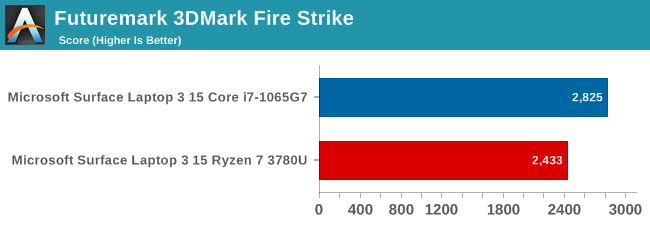
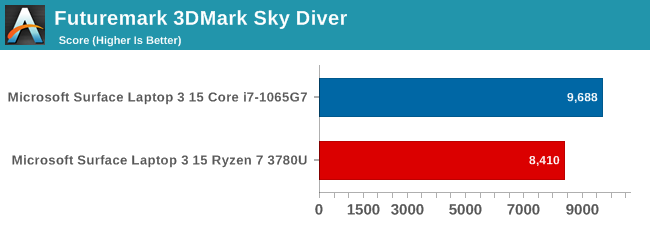
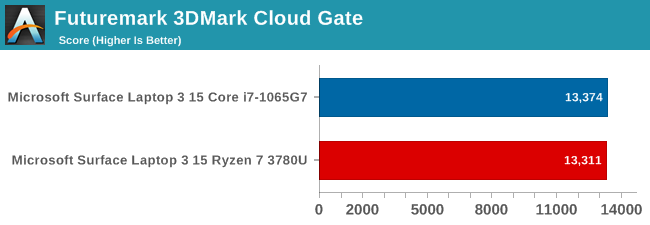

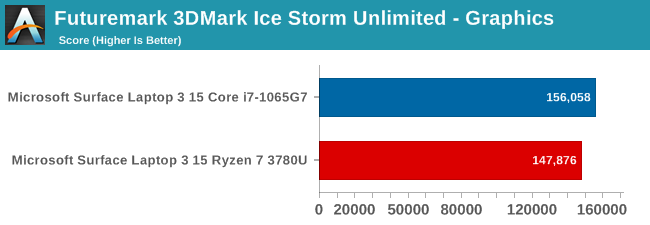
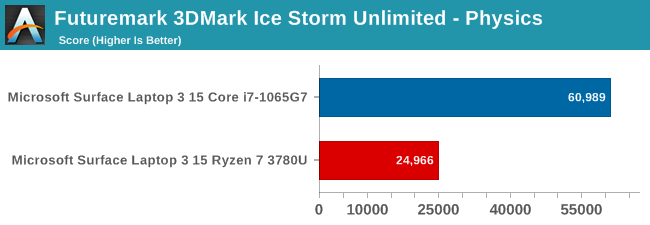
3DMark offers several tests of varying complexity, from Fire Strike as the most demanding, to Ice Storm Unlimited, which can be run on tablets. Here the Ice Lake platform pulls ahead, with better CPU performance helping quite a bit, although the Ice Lake’s Iris Plus graphics is also able to outperform Vega 11 as well.
GFXBench
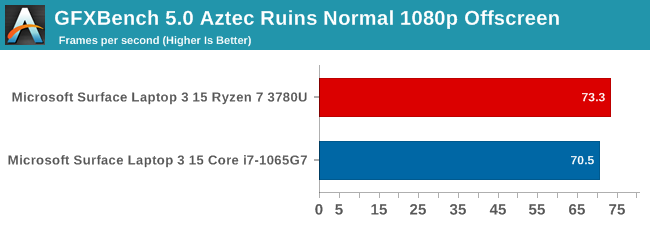
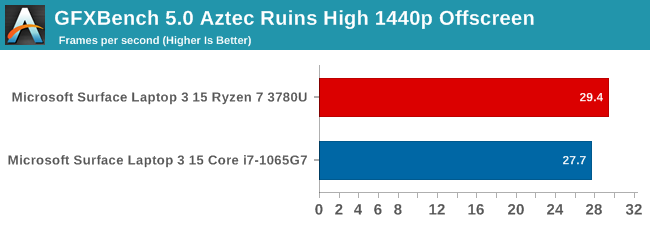
Kishonti’s latest GFXBench suite added DirectX 12 tests to the fold, making it far more relevant than the older OpenGL versions available on the desktop previously. AMD’s previous work in low-level drivers when they developed Mantle has provided the groundwork for DX12 as well, with Vega 11 offering slightly better results than Iris Plus in this test.
Tomb Raider
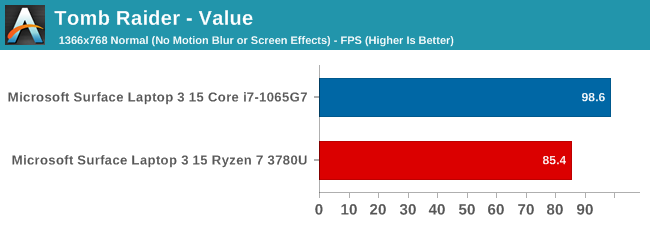
Running at our value settings, Tomb Raider was easily playable on both systems, with framerates approaching 100 FPS. The Ice Lake platform performed better on this test.
Rise of the Tomb Raider
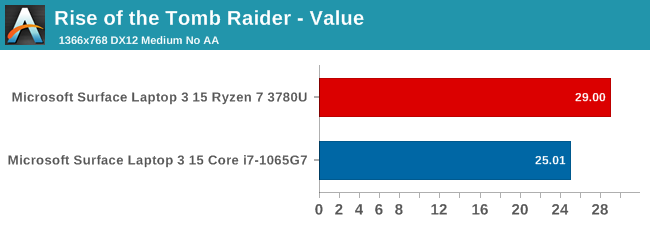
The second installment in the Tomb Raider series offers much more demanding visuals, and both systems struggle to play it at our value settings. The DirectX 12 title performs slightly better on Vega, and with some additional settings tweaks, the game would be playable, which is not something you could have said on an integrated GPU previous to Ryzen and Ice Lake.
Strange Brigade
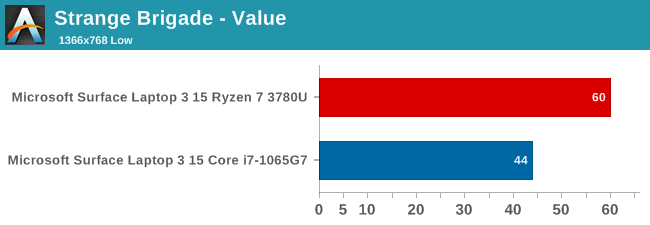
A new title we’re bringing to our laptop suite is Strange Brigade, which scales down nicely on integrated graphics. This game also supports DirectX 12, and as tends to be the pattern, performs very well on Vega 11.
F1 2017
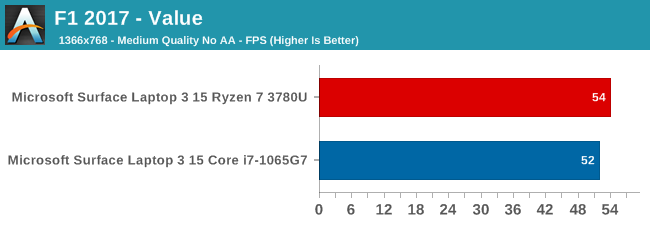
Back with a DirectX 11 title, we see that Intel has again closed the gap, and this game tends to be somewhat CPU bottlenecked as well, so the Sunny Cove cores likely help out here too, but once again Vega 11 wins, if only by a nose.
F1 2019

Codemasters updated the underlying EGO engine to support DirectX 12, which was utilized on this test. Despite that, the Vega 11 GPU is a bit slower than the Iris Plus in this test.
Far Cry 5
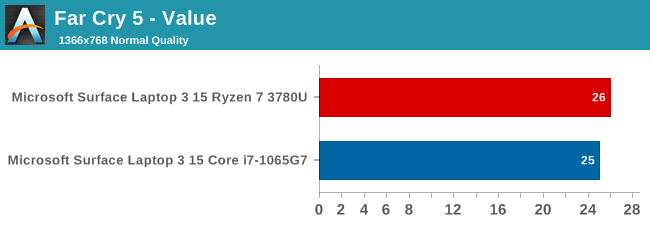
Both systems are within striking distance of being playable, which is somewhat remarkable since the Far Cry series is one of the most popular AAA first-person shooters. The Vega 11 GPU was slightly ahead, which is somewhat surprising as this game tends to be CPU bound, but clearly at this low of a GPU limit that hasn’t come into play yet.










174 Comments
View All Comments
kgardas - Friday, December 13, 2019 - link
Thanks for the great article! Intel surprised me a bit since this Ice Lake wonder looks like Zen2 or even better. Now, the only question is when we can get Ice Lake cores in Xeon E/W form?UglyFrank - Friday, December 13, 2019 - link
Coffee Lake & Zen+ were very close in IPC terms & Ice Lake & Zen 2 both had similar IPC increases from their predecessorsphilehidiot - Sunday, December 15, 2019 - link
We all knew what the CPU result was going to be, and really this is a great foot in the door for AMD for when they have a competitive mobile product. Given the relentless execution after execution, I'm hopeful for something good here. I suspect they've left laptops until last as that's where a lot of Intel's dirty tactics are in play and will be the hardest market to crack. Working with MS will undoubtedly give AMD some ideas of where they can optimise for Windows on their end and also get MS to optimise on theirs. Given that AMD are actually competitive now, I suspect Microsoft are more interested in dealing with them.The surprise for me was the GPU leap from Intel. I was expecting AMD's GPU option to be far better and Intel's to just be the usual perfunctory stuff, good only for multimedia and maybe Minecraft. That.... could be a sign of things to come, methinks.
Lolimaster - Monday, December 16, 2019 - link
Vega11 is the same as the Ryzen 2400G. Zen2+ mobile will be a major upshift.philehidiot - Tuesday, December 17, 2019 - link
I really hope you're right. It's great to finally see competition. I am actually considering upgrading my main PC for the first time in years. What I don't want is Intel abusing its market position to cane AMD in the GPU market with an inferior product.YB1064 - Tuesday, December 17, 2019 - link
I did not expect such a big improvement in IPC from Intel either. Looks like they were holding back. A desktop equivalent is going to snatch the CPU crown back from AMD. I just hope the platform price is not insane.cheshirster - Wednesday, December 18, 2019 - link
Problem is that 10nm can't hit high enough clocks.They are now backporting it to 14nm, and the result will have a questionable ... everithing other than performance in games.
eva02langley - Friday, December 13, 2019 - link
Really interesting. It just proves that AMD needs to upper their game in laptops, still it is jsut telling me that I should wait for Zen 2 mobile at this point.At least, i know what I will buy in the future.
Targon - Friday, December 13, 2019 - link
7nm AMD laptop chips are expected to show up in January at CES, potentially even shipping at that point. With the 15% IPC boost, that will help a lot. If Zen3 brings another 15% IPC boost(something that has been rumored), then in January 2021 we might see AMD beating Intel in the laptop space(since Intel doesn't improve IPC all that often).RSAUser - Friday, December 13, 2019 - link
I think it will probably be higher once Zen3 ships as node will either have had a process improvement or shrunk to 5nm.Current AMD mobile is pretty bad, hope they get competitive and bring laptop prices down.